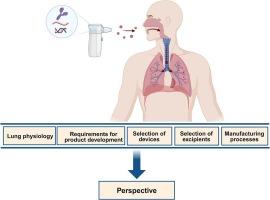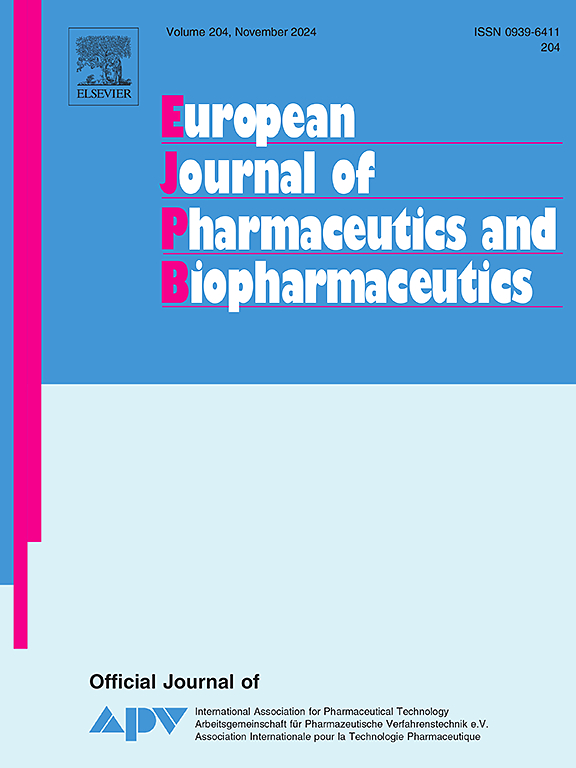用于肺部输送生物制剂的配方策略、制备方法和设备。
IF 4.4
2区 医学
Q1 PHARMACOLOGY & PHARMACY
European Journal of Pharmaceutics and Biopharmaceutics
Pub Date : 2024-10-10
DOI:10.1016/j.ejpb.2024.114530
引用次数: 0
摘要
生物制品,包括疫苗、血液成分和重组治疗蛋白,均来自天然来源,如人类、动物或微生物,通常采用先进的生物技术方法生产。生物制剂(尤其是单克隆抗体)的成功归功于其良好的安全性和靶向特异性。然而,它们的大分子尺寸给给药带来了巨大挑战,尤其是在克服生物障碍方面。肺部给药已成为一种很有前景的生物制剂给药途径,它具有非侵入性给药,吸收快,全身生物利用度高,避免了首过代谢等优点。本综述首先详细介绍了呼吸道的解剖结构和生理屏障,以及肺部给药的相关挑战。它进一步讨论了肺部给药(PDD)的创新、颗粒大小对药物沉积的影响以及使用纳米颗粒等二次颗粒来提高生物利用度和靶向性。该综述还解释了用于 PDD 的各种设备,包括干粉吸入器 (DPI) 和雾化器,强调了它们在给药生物制剂方面的优势和局限性。此外,还探讨了辅料在提高吸入产品稳定性和性能方面的作用。由于干粉被认为是输送生物分子的最合适形式,因此文章特别强调了干粉吸入剂开发中使用的辅料。文章的最后一部分回顾并比较了各种干粉制造方法,阐明了这些方法的临床意义以及未来在吸入式药物制剂领域的应用潜力。本文章由计算机程序翻译,如有差异,请以英文原文为准。

Formulation strategies, preparation methods, and devices for pulmonary delivery of biologics
Biological products, including vaccines, blood components, and recombinant therapeutic proteins, are derived from natural sources such as humans, animals, or microorganisms and are typically produced using advanced biotechnological methods. The success of biologics, particularly monoclonal antibodies, can be attributed to their favorable safety profiles and target specificity. However, their large molecular size presents significant challenges in drug delivery, particularly in overcoming biological barriers. Pulmonary delivery has emerged as a promising route for administering biologics, offering non-invasive delivery with rapid absorption, high systemic bioavailability, and avoidance of first-pass metabolism. This review first details the anatomy and physiological barriers of the respiratory tract and the associated challenges of pulmonary drug delivery (PDD). It further discusses innovations in PDD, the impact of particle size on drug deposition, and the use of secondary particles, such as nanoparticles, to enhance bioavailability and targeting. The review also explains various devices used for PDD, including dry powder inhalers (DPIs) and nebulizers, highlighting their advantages and limitations in delivering biologics. The role of excipients in improving the stability and performance of inhalation products is also addressed. Since dry powders are considered the suitable format for delivering biomolecules, particular emphasis is placed on the excipients used in DPI development. The final section of the article reviews and compares various dry powder manufacturing methods, clarifying their clinical relevance and potential for future applications in the field of inhalable drug formulation.
求助全文
通过发布文献求助,成功后即可免费获取论文全文。
去求助
来源期刊
CiteScore
8.80
自引率
4.10%
发文量
211
审稿时长
36 days
期刊介绍:
The European Journal of Pharmaceutics and Biopharmaceutics provides a medium for the publication of novel, innovative and hypothesis-driven research from the areas of Pharmaceutics and Biopharmaceutics.
Topics covered include for example:
Design and development of drug delivery systems for pharmaceuticals and biopharmaceuticals (small molecules, proteins, nucleic acids)
Aspects of manufacturing process design
Biomedical aspects of drug product design
Strategies and formulations for controlled drug transport across biological barriers
Physicochemical aspects of drug product development
Novel excipients for drug product design
Drug delivery and controlled release systems for systemic and local applications
Nanomaterials for therapeutic and diagnostic purposes
Advanced therapy medicinal products
Medical devices supporting a distinct pharmacological effect.

 求助内容:
求助内容: 应助结果提醒方式:
应助结果提醒方式:


